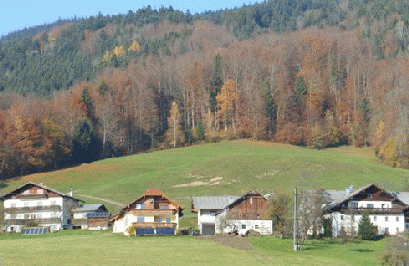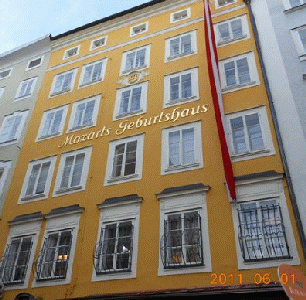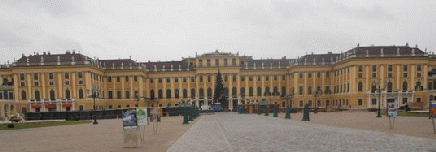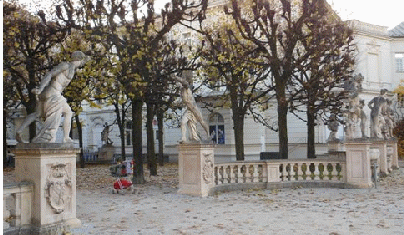

When friends and acquaintances heard that I was to take a trip on the Danube everyone was anxious to tell me the Danube was no longer blue; however I found that beauty really is in the eye of the beholder and blue it was to me. I first heard of this famous river from my piano teacher as she taught me the Strauss waltz and gave me a romantic story of traveling its winding path from Germany to Austria and Hungary.
In 1976 my husband Ken and I took two of our children on a European trip that included a memorable, but rather primitive by today’s standards, barge trip down the Burgundy Canal in France. Since then my trips have been on larger ships with an increasing number of passengers that were far more sophisticated than our river experience, but more and more the voyages became impersonal and left me with a crowded feeling.
I first heard of the AMA Waterways trip from my local travel agent, Judy Van Dyke at Camarillo Travel. Not only was my special river involved but the theme of the trip was “A Celebration of Wine,” a perfect combination for me. It offered a wine tasting and lecture every day as we sailed to the next port. Also available was a smaller presentation and tasting by a family winery from Oregon, which would share both its wine and information. There was even a beer fest on board! Once a year my daughter and I plan a trip or activity to share and when we read the details we signed up for the ship AmaLyra.
Every morning we set sail for a port of call on our river. We started off each day in the dining room with a self-serve buffet, but there also was a chef who took your egg or specialty order and somehow knew your preferences the next day. Friendly waiters seated you and served your beverage of choice. There were the usual warming trays with bacon and potatoes, plus fruits that not only were attractive but ripe and delicious. The seating was open for all meals and we took advantage of that to meet new people each day.

The ship offered a guided tour at each port. Guests were able to pick their own pace; there were fast pace and bike riders, moderate, and gentle to choose from. Our first port was Passau, a frontier town between Germany and Austria, the town of the three rivers. It has a 200-year-old history, and its walls still stand as proof of the presence of the Roman armies. The medieval historical center of Passau is located between the Danube and the Inn Rivers where you will find the symbol of Passau, St. Stephan’s Cathedral.
The next morning on our way to Linz our “In Celebration of Wine” host, Burke Owens, conducted our first wine tasting in the AmaLyra Lounge. A familiar treat to me it was as we compared two West Coast wine regions: Santa Barbara and Sonoma counties. There were quite a few people from Texas and California, plus many scattered over the United States and Canada. I found almost all of them were quite knowledgeable about California wines (and those from other locations as well).
Our afternoon excursion to Salzburg was one of the highlights of the tour. Salzburg is a charming mountain town, just over the Czech-Austrian border. We took a three-hour ride through the countryside to reach the city. We began our visit with a walking tour in the historic center that was the setting for the “Sound of Music,” probably one of the best known movies in cinematic history as it is revisited every Christmas. It was fun to see many of the places that were featured in the film, such as the Mirabel Gardens where Maria and the von Trapp children sang “Do Re Me.” However, I put my fingers in my ears as the guide pointed out all of the places and storylines of the film that were inaccurate. I prefer to remember the happily-ever-after movie. Other than the von Trapps, probably the most famous citizen was of the area was Mozart. We had a chance to visit the Salzburg Cathedral where Mozart was the court organist and took time to visit the Mozart museum, certainly well worth the side trip.

Awaiting us back at the ship was a paired wine dinner. The Executive Chef crafted a feast to highlight and complement the wines of Schloss Gobelsburg. Following this feast we were treated to a discussion of Austria’s wine industry titled “Austria – The Wine World’s Comeback Kid!” by Burke Owen.
The next day found the ship cruising through the narrow Strudengau to reach the Wachau Valley. We gathered in the lounge while we traveled for another interesting wine lecture before arriving in Linz. This time Host Owens spoke about the Russian River Valley and the rise of Sonoma County. Again, the information was familiar but contained new topics as well. His information was accompanied with a tasting of outstanding glasses of wine from both areas.
After lunch we took buses for the short drive to the Melk Monastery. Our tour took us through the exhibition on St. Benedict and the world-famous library that inspired Umberto Eco to write the book, “The Name of the Rose.” Next we were transported to the Abbey of Gottweig, also called “Austrian Monte Cassino,” for a tasting of the Abbey’s wines. The Abbey was founded in 1083 and is ensconced at 1,473 feet above sea level in the Wachau Valley. It is a World Heritage Site since 2001 but more important it is the spiritual center of lower Austria. The Stift Gottweig Wine Estate is located on the right bank of the Danube in the wine-growing area of Kremstal. This area has a mild climate with cool forest winds and provides rich aromas and flavors to the wines. They are dry, displaying a unique freshness, considered to be the best white wines in Austria, including world-class Rieslings.
We had been alerted to the fact that this morning the AmaLyra would be passing through one of the most beautiful stretches of our journey so we watched it go by as we leisurely ate our breakfast then moved to the sundeck. Autumn temperatures being what they are, the less hardy of us moved to enjoy the view from the lounge. Before us lay the Wachau Gorge, vineyards, castles, houses, and villages looking like something right out of a storybook.
This day on our voyage was special because we visited two small towns, Durnstein and Krems. Durnstein flourished in the Middle Ages due to its ideal location. The steep rock riverbanks gave protection against floods and left enough space for settlement and fortification. Today it is one of the smallest cities in Austria with a population of less than 1,000. Because of the steep, cobbled slopes the town has a Pepto Bismo-pink choo-choo to take less agile visitors around. Overlooking the town are the ruins of the castle where the English King Richard the Lionhearted was held prisoner in 1192-1193.
While enjoying our lunch we took a short, picturesque sail to reach Krems, the center of Wachau’s wine industry. In the 11th and 12th centuries Krems was as large as Vienna but now is a small town noted for its wines and vineyards. A short bus ride spirited us to Schloss Gobelburg Castle. Its motto: “a thousand years of wine.” The winery strives to keep the spirit of the monks by the simplicity and strictness of its wines. The finished product displays an unadorned expression of the terroir (terroir being the interaction between soil, rock, microclimate, and the experience of generations). Shadowed by centuries of history, castle and countryside testify to a continuous cultivation reaching back into the Bronze Age. After a tour of the winery we were ushered into the grand ballroom, where once 200 revelers danced and dined. We were treated to both wine and small plates of pastries, and then traveled back to the ship.

One of the evening’s offerings was a visit to the Loisium World of Wine experience. The Loisium showcases and presents a large variety wines that are produced in the region. The structure itself is a futuristic building, a cubical structure with stainless steel outside and pure organic cork walls inside. Visitors were offered a small meal as after a tour of the exhibition the guests were treated to a “Heruigen” buffet: cold cuts, sliced pork and chicken, deviled eggs, pickles, hot peppers, cheese and tomatoes with different spreads and breads while the “Heruigen” musician played the accordion. The ship departed for Vienna after the passengers returned.
The city I most looked forward to seeing was Vienna and it did not disappoint, especially since our outing was designated as the Culinary Delights Tour. We started the day right with a cup of piping-hot Austrian coffee paired with a slice of sachertorte, a rich chocolate cake. This confection consisted of thin layers of apricot jam, a chocolate glaze and whipped cream. This treat was served at the Hofburg Café, a Viennese coffeehouse located in the Imperial Palace. Now we were alert and ready to visit the Ringstrasse, the central circle of the town lined with building, monuments and parks. No wonder it is considered a UNESCO World Heritage Site.
The next part of the Vienna delights program was a visit to the Schlumberger Sparkling Winery. Although the winery has a tradition leading back to l842, the glamorous tasting room is starkly modern, done in shades of bright gold and white. In contrast, the 300-year-old wine cellar is an impressive underground labyrinth. The tour finished generous servings of its superb sparkling wine
No wonder everyone loves Vienna – the best was yet to come with an outing to the Schonbrunn Palace and Gardens. My son had visited this famous city years before and Schonbrunn was his “must see” recommendation. In the 17th century King Leopold commissioned an architect to build a hunting lodge for the heir to the throne. Half a century later under Maria Teresa the palace became the focus of court life. Between 1743 and 1763 the former lodge was transformed into grand imperial residence which was decorated in the Rococo style. The ownership of the palace passed to the Republic of Austria with the end of the monarchy in 1918 and is a treasure for the ages.

A trip to the Aukersperg Palais is a must for those wanting to experience a night of classical music as they are treated to a Mozart and Strauss concert. At the end of the evening the group is escorted to the ship by driving through the magical ring boulevard which is illuminated for the pleasure of the visitors. The other choice is a traditional wine and music evening presented from locals from Vienna who came aboard for music and dancing. They were a talented group of performers. What an evening of fun as the passengers were whisked on to the floor and involved like it or not (and they loved it!).
The last stop on this magical voyage was Budapest, Hungary. Getting there was made special with one more wine lecture and tasting. Once arriving there were two choices, one a guided tour which includes the historic Buda Castle, Fisherman’s Bastion, the Royal Palace, and St. Stephens Basilica. The other choice was a Culinary Delight Tour. After a farewell Hungarian dinner with folk music the ship set sail for a special “Illuminations Cruise” past the glowing river front of the city. I found that Budapest was so special that it has a story all to itself for another day.
AMA Waterways Cruises, www.AmaWaterways.com . Camarillo Travel, www.camarillotravel.com 2310 E Ponderosa Dr Camarillo, CA 93010, (805) 484-2863
.

Graphic Design by Impact Graphics